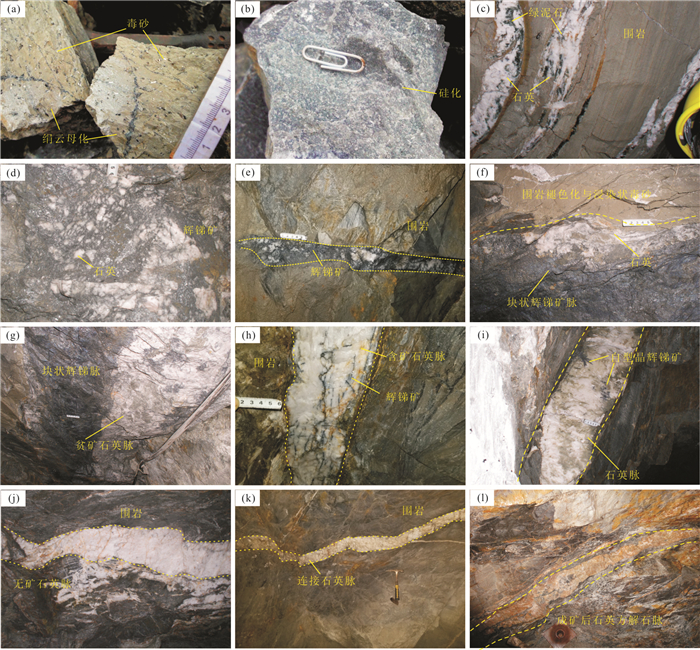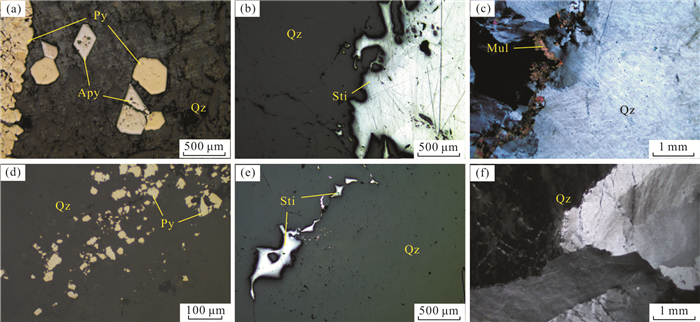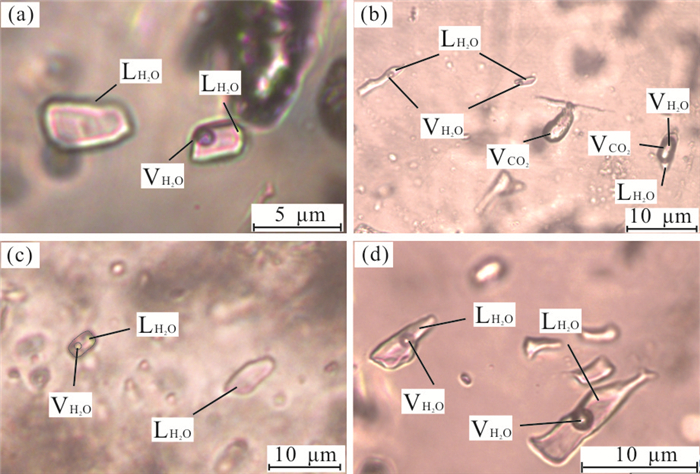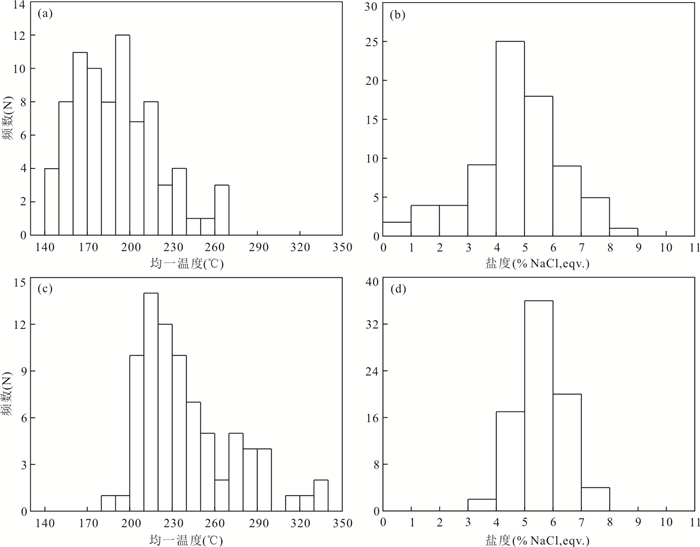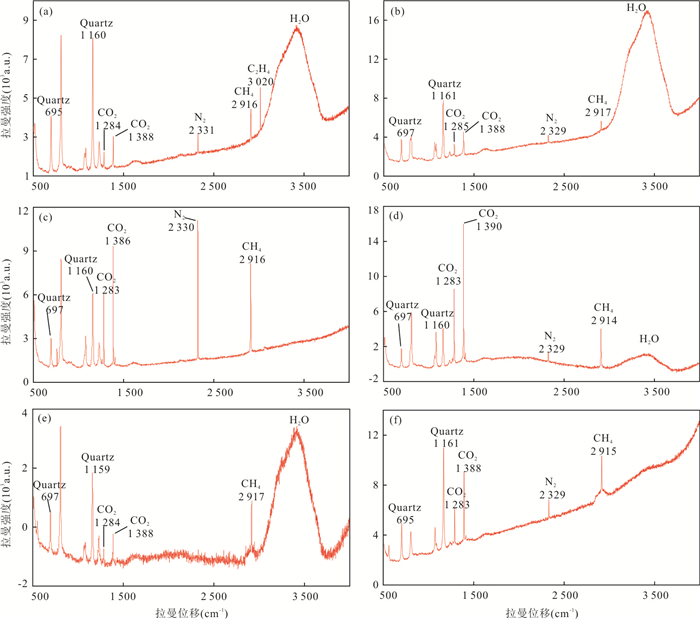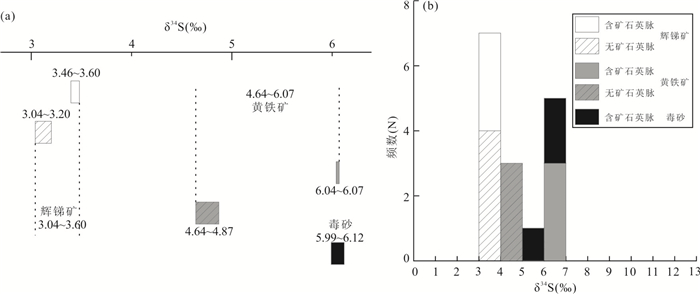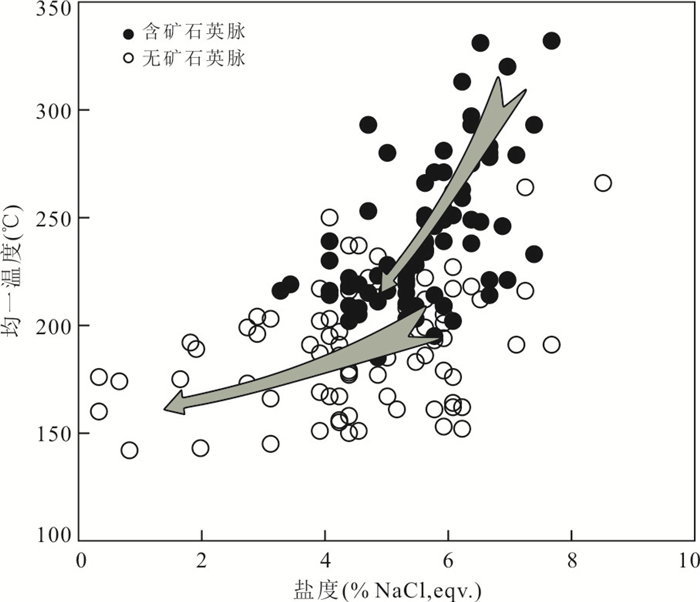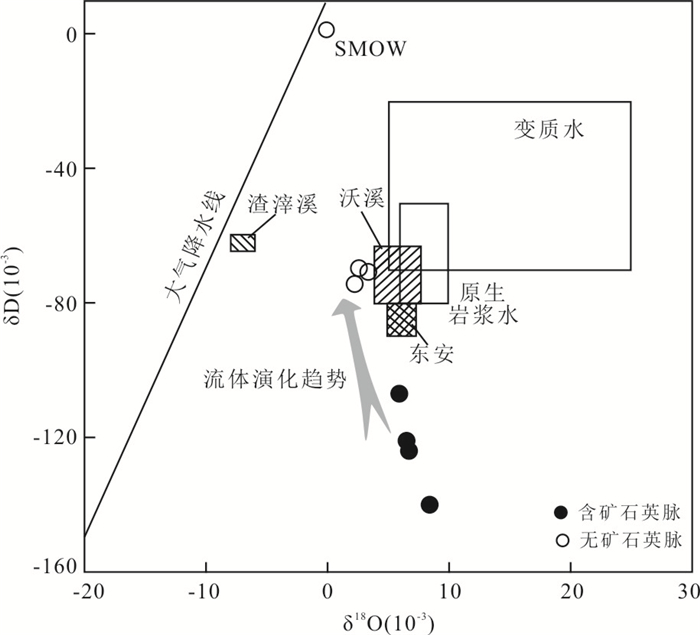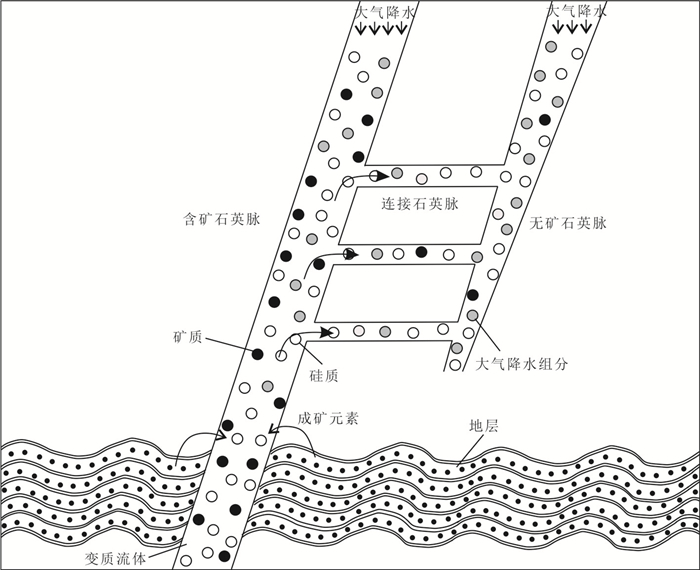The Genesis of Two Types of Quartz Veins in Banxi Antimony Deposit and Their Prospecting Significance
-
摘要: 板溪矿区内广泛发育无矿石英脉,其与含矿石英脉空间关系密切,但人们对两者是否具有成因联系并不清楚.围绕该问题作者开展了二者形成时代、成分组成及物质来源等方面的对比研究,结果发现含矿石英脉旁侧总是发育与其平行的无矿石英脉,二者无穿插关系,但存在连接二者的石英脉,结合区域地质资料认为无矿石英脉形成于燕山期,与含矿石英脉形成时代一致;无矿石英脉局部含微量辉锑矿±黄铁矿,脉体发育绢云母化、硅化等围岩蚀变,与含矿石英脉一致;无矿石英脉流体包裹体均一温度(143~266℃)和盐度(1.7%~8.5% NaCl eqv.)较含矿石英脉的均一温度(185~332℃)和盐度(3.3%~7.7% NaCl eqv.)略低,但二者均为中低温、低盐度的流体体系;激光拉曼分析显示两者流体气相组分均为H2O±CO2±CH4±N2,LA-ICP-MS测试结果显示无矿石英脉与含矿石英脉均含Sb、Fe、As等元素;无矿石英脉包裹体的δD值(-74.4‰~-69.7‰)、δ18OH2O值(2.6‰~3.4‰)、硫化物δ34S值(3.04‰~4.87‰)与含矿石英脉包裹体的δD值(-140‰~-107‰)、δ18OH2O值(5.9‰~8.4‰)、硫化物δ34S值(3.46‰~6.12‰)相似性较高,指示二者具有相同的物质来源.两类石英脉应属同一成矿热液系统,其差异是成矿流体混合的结果,因此其他热液矿床,特别是矿田范围内的无矿石英脉可能对矿脉具有指示作用,应引起重视.Abstract: The Banxi antimony deposit is located in the Central Hunan Sb belt,which is a quartz vein type deposit that has been mined for more than 100 years. Like many hydrothermal deposits,the Banxi deposit has many ore-free quartz veins,which are parallel with the ore-bearing quartz veins at a relatively fixed distance. However,the genetic connection between ore-free and ore-bearing veins is not clear. Based on the comparison of the forming age and fluid components of the two types of quartz veins,the genetic relationship between the two types of quartz veins and the possible geological significance of the ore-free quartz veins are discussed. Field observations,examination of fluid inclusions and hydrogen,oxygen,and sulfur isotope analyses reveal that the two types of quartz veins has no interpenetrating relationship,but the ore-free and ore-bearing veins are physically connected. Integrated with regional geological data,it is concluded that the ore-free vein was formed in Yanshanian period,which was consistent with the ore-bearing vein. The ore-free quartz veins contain a small amount of stibnite and pyrite. Sericitization,silicification and other types of wall rock alteration are both developed on the side of the two types of veins. Micro thermometric analyses of fluid inclusion in ore-free quartz veins yield homogenization temperature ranges of 143-266 ℃ and salinities of 1.7%-8.5% NaCl eqv.. While ore-bearing quartz veins inclusions have ranges of 185-332 ℃ with salinities of 3.3%-7.7% NaCl eqv.,showing that both types of veins formed in medium-low temperature and low salinity fluid systems. Laser Raman analyses of a fluid inclusion from both types of veins show that the gas phase components of both fluids are H2O±CO2±CH4±N2. LA-ICP-MS test results confirm that both types of veins contain the same elements (Sb,Fe,As,etc.),and that their fluid components are very similar. The values of δD and δ18OH2O of the ore-free quartz veins vary from -69.7‰ to -74.4‰,and 2.6‰ to 3.4‰,while the values in ore-bearing quartz vein vary from -140‰ to -107‰,and 5.9‰ to 8.4‰. The values of δ34S of sulfide are 3.04‰-4.87‰ (ore-free quartz vein) and 3.46‰-6.12‰ (ore-bearing quartz vein). Previous geologic work and field observations during this study indicate that quartz porphyry veins in the mining area developed without significant magmatic activity. This suggests that the original fluid for both types of veins was metamorphic water,and that the nature of quartz veins changed with time,regional cooling and different levels of meteoric water participation. In both types of veins,sulfur found in sulfides was derived from the host formation. The spatial relationship between the two types of quartz veins and their similar components and sources of ore-forming materials indicate that the two types of quartz veins are close to the same age of formation and belong to the same metallogenic hydrothermal system. The slight difference in geological and geochemical characteristics between the two types of quartz veins is the result of the continuous evolution and differentiation of ore-forming fluids. The study of the genetic relationship between the two types of quartz veins provides an example for the study of the ore-forming fluid mixing of this type of deposit. The distribution characteristics of the two types of quartz veins parallel at a relatively fixed distance not only provide a new mark for prospecting for banxi antimony deposit,but also enlighten us to pay attention to the possible indicating role of ore-free quartz veins in some deposits of this type or in the new exploration area for the ore-bearing quartz veins.
-
图 1 板溪锑矿床地质简图
a.板溪锑矿区域地质图(彭建堂等, 2008);b.板溪锑矿矿区及边部地质图(Li et al., 2018);c.板溪锑矿8线石英脉空间关系剖面图;d.板溪锑矿19中段石英脉空间关系平面图;e.板溪锑矿17中段石英脉空间关系平面图. 1.三叠系-泥盆系地层; 2.元古界地层; 3.志留系-震旦系地层; 4.花岗岩; 5.锑矿点; 6.断层; 7.板溪群五强溪组上段第三亚段; 8.板溪群五强溪组上段第二亚段; 9.板溪群五强溪组上段第一亚段; 10.蚀变带; 11.勘探线; 12.含矿石英脉; 13.无矿石英脉; 14.巷道; 15.钻孔; 16.采样位置
Fig. 1. Geologic sketch map of the Banxi antimony deposit
图 2 板溪锑矿两类石英脉野外地质特征
a.绢云母化和毒砂化围岩;b.硅化围岩;c.无矿石英脉中的绿泥石;d.含矿石英脉中的稠密细脉浸染状辉锑矿和角砾状石英;e.含矿石英脉中稠密浸染状辉锑矿,块状辉锑矿围岩发生强烈的褪色化与毒砂化;f.含矿石英脉中稀疏细脉浸染状辉锑矿;g.富矿石英脉与贫矿石英脉平行排列;h.含细脉状辉锑矿的石英脉;i.含星点状辉锑矿的石英脉;j.不规则状无矿石英脉;k.连接无矿与含矿脉的缓倾石英脉;l.成矿后石英方解石脉
Fig. 2. Field geological characteristics of ore-free and ore-bearing quartz veins in Banxi antimony deposit
图 9 板溪锑矿石英H-O同位素图解
底图据Taylor(1974);渣滓溪矿床数据据何江等(1996);沃溪矿床数据据何谷先(1996);东安矿床数据据郭碧莹(2014)
Fig. 9. Plot of δD-δ18OH2O of the fluids in the Banxi antimony deposit
表 1 板溪锑矿包裹体样品采集位置
Table 1. Sampling location of the Banxi ore deposit
样品号 采样位置 石英脉类型 矿物组合 BX1 19中段20与16线间穿脉脉壁 无矿石英脉 石英 BX2 18中段20线脉外巷 石英 BX3 17中段20与22线间脉外巷 石英+辉锑矿(微量)+黄铁矿(微量) BX4 16中段20线附近沿脉 石英+辉锑矿(微量) BX5 11中段19线 含矿石英脉 辉锑矿+石英 BX6 8中段2-2号矿体西端尾部 辉锑矿+石英 BX7 17中段28线 辉锑矿+石英+黄铁矿+毒砂 BX8 14中段2-1号矿体 辉锑矿+石英+黄铁矿 12D19S1 15中段22线 辉锑矿+石英 21D1S1 15中段11线 辉锑矿+石英 17D8S2 17中段32线至28线 辉锑矿+石英 802-1S1 17中段东端12线 辉锑矿+石英 表 2 板溪锑矿床流体包裹体显微测温结果统计
Table 2. Microthermometric data of fluid inclusion in the Banxi Sb deposit
石英脉类型 样品编号 包裹体类型 数目 大小(μm) Tm(℃) Th(℃) w(NaCl eqv.)(%) ρ(g/cm3) 范围 平均值 范围 平均值 范围 平均值 范围 平均值 无矿石英脉 BX1 Ⅰ 20 2~9 -5.5~-0.4 -2.8 159~262 210.6 0.6~8.5 4.5 0.86~0.92 0.891 BX2 Ⅰ 20 3~12 -3.8~-1.9 -2.9 155~239 180.5 3.1~6.1 4.8 0.89~0.96 0.927 BX3 Ⅰ 20 2~10 -4.1~-0.2 -2.6 142~232 189.6 0.3~6.5 4.2 0.88~0.96 0.911 BX4 Ⅰ 18 2~10 -4.9~-1.2 -3.1 143~216 181.2 2.0~7.7 5.0 0.89~0.96 0.932 含矿石英脉 BX5 Ⅰ 20 2~8 -4.9~-2.0 -3.7 185~332 244.6 3.3~7.7 6.0 0.74~0.92 0.863 BX6 Ⅰ 19 2~13 -4.7~-3.3 -4.0 203~320 257.3 5.3~7.4 6.3 0.59~0.90 0.829 BX7 Ⅰ 20 3~11 -3.7~-2.1 -3.1 203~293 236.1 3.4~5.9 5.0 0.77~0.91 0.863 BX8 Ⅰ 20 2~15 -2.7~-3.7 -3.2 202~249 225.3 4.4~5.9 5.2 0.86~0.90 0.880 注:流体的盐度和密度由FLINCOR程序(Brown,1989)计算所得. 表 3 板溪锑矿流体包裹体LA-ICP-MS分析结果(10-6)
Table 3. LA-ICP-MS analysis results of fluid inclusions in the Banxi antimony deposit (10-6)
石英脉类型 序号 Fe Ni As Rb Sr Sn Sb Te Cs Ba W 无矿石英脉 1 2 626.7 39.5 28.3 6.2 17.0 45.6 412.5 44.2 7.7 13.2 0.4 2 1 447.7 63.3 171.7 8.9 44.9 196.9 1 058.0 13.5 10.5 23.7 5.3 3 2 501.0 41.7 155.0 16.9 24.1 41.9 166.2 8.0 3.7 16.2 4.2 4 2 943.0 250.8 76.9 14.1 58.2 101.9 864.0 56.8 8.4 43.0 11.4 5 4 205.8 38.9 23.3 5.8 31.0 37.1 46.3 15.5 18.1 50.1 4.0 6 534.9 20.8 13.7 2.4 29.3 84.7 697.7 10.7 25.2 5.0 2.8 7 9 732.4 112.2 25.5 5.9 131.6 289.9 269.9 134.6 53.4 15.6 28.5 8 853.7 77.5 - 5.3 19.0 27.9 208.6 - 1.9 12.1 0.9 均值 3 105.7 80.6 70.6 8.2 44.4 103.3 465.4 40.5 16.1 22.4 7.2 含矿石英脉 1 - 1 011.6 160.1 - 82.7 125.9 4 631.1 - 34.9 - 102.5 2 13 809.5 - 476.3 34.0 - - 2 999.2 742.7 - - 2.6 3 5 331.9 228.7 608.4 0.3 88.7 92.2 3 058.1 400.4 33.9 127.3 - 4 9 761.5 53.7 370.7 12.3 15.0 341.5 791.4 4.4 - 303.7 22.2 5 8 333.8 71.5 369.7 62.6 74.9 - 3 237.7 - 61.1 237.0 5.1 均值 9 309.2 341.4 397.0 27.3 65.4 186.5 2 943.5 382.5 43.3 222.7 33.1 注:“-”为低于检测限;表中数据使用SILLS软件( Guillong et al., 2008 )处理.表 4 板溪锑矿石英脉H-O同位素组成
Table 4. H and O isotope composition of quartz vein in the Banxi antimony deposit
样品编号 石英脉类型 测试矿物 δDV-SMOW(‰) δ18OV-SMOW(‰) δ18OH2O(‰) 均一温度(℃) BX2 无矿石英脉 石英 -69.7 15.6 2.6 181 BX3 -70.8 15.4 3.4 195 BX4 -74.4 15.2 2.2 181 12D19S1 含矿石英脉 石英 -140 17.2 8.4 253 21D1S1 -124 16.5 6.7 233 17D8S2 -121 15.9 6.5 240 802-1S1 -107 16.1 5.9 225 表 5 板溪锑矿硫化物S同位素组成
Table 5. S isotope composition of sulfides in the Banxi antimony deposit
样品号 硫化物类型 石英脉类型 δ34S (‰) BX-3-1 辉锑矿 无矿石英脉 3.18 BX-3-2 辉锑矿 3.04 BX-4-1 辉锑矿 3.10 BX-4-2 辉锑矿 3.20 BX-3-3 黄铁矿 4.87 BX-3-4 黄铁矿 4.64 BX-3-5 黄铁矿 4.87 BX-7-1 辉锑矿 含矿石英脉 3.46 BX-7-2 辉锑矿 3.60 BX-7-3 辉锑矿 3.46 BX-7-4 黄铁矿 6.06 BX-7-5 黄铁矿 6.04 BX-7-6 黄铁矿 6.07 BX-7-7 毒砂 6.12 BX-7-8 毒砂 5.99 BX-7-9 毒砂 6.12 -
Ashrafpour, E., Ansdell, K.M., Alirezaei, S., 2012.Hydrothermal Fluid Evolution and Ore Genesis in the Arghash Epithermal Gold Prospect, Northeastern Iran. Journal of Asian Earth Sciences, 51:30-44. doi: 10.1016/j.jseaes.2012.01.020 Borovikov, A.A., Lapukhov, A. S., Borisenko, A. S., et al., 2009.The Asachinskoe Epithermal Au-Ag Deposit in Southern Kamchatka:Physicochemical Conditions of Formation. Russian Geology and Geophysics, 50:693-702. doi: 10.1016/j.rgg.2008.12.011 Brown, P.E., 1989.FLINCOR:A Microcomputer Program for the Reduction and Investigation of Fluid Inclusion Data. American Mineralogist, 74:1390-1393. Choi, S. H., 1998.Geochemical Evolution of Hydrothermal Fluids at the Daejang Cu-Zn-Pb Vein Deposit, Korea. Resource Geology, 48:171-182. doi: 10.1111/j.1751-3928.1998.tb00015.x Clayton, R.N., O'Neil, J.R., Mayeda, T., 1972.Oxygen Isotope Exchange between Quartz and Water. Journal of Geophysical Research Atmosphers, 77(17):3057-3067. doi: 10.1029/JB077i017p03057 Fan, Q.H., Mo, J.Q., Li, Y.Z., 1985.A Preliminary Study of the Migration Direction of Ore Fluids in Special Reference to Fluid Inclusion Data from Banxi Antimeny Mine, Huan Province. Acta Mineralogica Sinica, 5(1):10-14 (in Chinese with English abstract). Guillong, M., Meier, D.L., Allan, M. M., et al., 2008.SILLS: A MATLAB-Based Program for the Reduction of Laser Ablation ICP-MS Data of Homoge-neous Materials and Inclusions. In: Sylvester, P., ed., Laser Ablation ICP-MS in the Earth Sciences: Current Practices and Outstanding Issues. Mineralogical Association of Canada Short Course Series, 40: 328-333. Guo, B.Y., 2014. Characteristics of Fluid Inclusions and Genesis of Dongan Antimony Deposit, Hunan Province. Master Thesis. Central South University, Changsha(in Chinese with English abstract). Hagemann, S.G., Luders, V., 2003. P-T-X Conditions of Hydrothermal Fluids and Precipitation Mechanism of Stibnite-Gold Mineralization at the Wiluna Lode-Gold Deposits, Western Australia:Conventional and Infrared Microthermometric Constraints. Mineralium, Deposita, 38(8), 936-952. doi: 10.1007/s00126-003-0351-6 He, G., 1996.Geological Features and Ore-Hunting Prospects of Woxi Gold Deposit in Western Huan. Gold Geology, 2(2):45-49 (in Chinese with English abstract). He, J., Ma, D.S., Liu, Y.J., et al., 1996.Geochemistry of Mineralization in the Zhazixi Antimony Ore Belt on the Margin of the Jiangan Old Land. Mineral Deposits, 15(1):41-52 (in Chinese with English abstract). Hu, X.W., Pei, R.F., Zhou, S., 1996. Sm-Nd Dating for Antimony Mineralization in the Xikuangshan Deposit, Hunan, China. Resource Geology, 46(4):227-231. Krupp, R.E., 1988.Solubility of Stibnite in Hydrogen Sulfide Solutions, Speciation, and Equilibrium-Constants, from 25 to 350℃. Geochimica et Cosmochimica Acta, 52(12):3005-3015. doi: 10.1016/0016-7037(88)90164-0 Lan, T.G., Hu, R.Z., Fan, H.R., et al., 2017.In-Situ Analysis of Major and Trace Elements in Fluid Inclusion and Quartz:LA-ICP-MS Method and Applications to Ore Deposits. Acta Petrologica Sinica, 33(10):3239-3262 (in Chinese with English abstract). Lee, C.H., Shin, D., 2009.Stable Isotope Characteristics and Evolution of Mineralizing Fluids in the Au-Ag-Sb Mineralized District in Northern Taebaegsan Region, Korea. Journal of the Geological Society of Korea, 45:261-274. Li, H., Wu, Q.H., Evans, N. J., et al., 2018.Geochemistry and Geochronology of the Banxi Sb Deposit:Implications for Fluid Origin and the Evolution of Sb Mineralization in Central-Western Hunan, South China. Gondwana Research, 55:112-134. doi: 10.1016/j.gr.2017.11.010 Li, J.L., Wang, M.Y., He, L., et al., 2014.Characteristics of the Ore-Forming Fluids and Its Constraints on the Genesis of Abra Pb-Cu Deposit, Western Australia. Geotectonica et Metallogenia, 38(3):598-608 (in Chinese with English abstract). http://www.wanfangdata.com.cn/details/detail.do?_type=perio&id=ddgzyckx201403012 Ma, D.S., 1999. Regional Pattern of Element Composition and Fluid Character in Medium-Low Temperature Metallogenic Province of South China. Mineral Deposits, 18(4):347-385 (in Chinese with English abstract). http://www.wanfangdata.com.cn/details/detail.do?_type=perio&id=kcdz199904008 Ma, D.S., Pan, J.Y., Lu, X.W., 2002. Geochemical Signals for Ore-Forming Process by Mid-Low Temperature Fluid in Au-Sb Deposits in NW-Central Hunan, China. Journal of Nanjing University (Natural Sciences), 38(3):435-445 (in Chinese with English abstract). http://www.wanfangdata.com.cn/details/detail.do?_type=perio&id=njdxxb200203017 Neyedley, K., Hanley, J.J., Fayek, M., et al., 2017.Textural, Fluid Inclusion, and Stable Oxygen Isotope Constraints on Vein Formation and Gold Precipitation at the 007 Deposit, Rice Lake Greenstone Belt, Bissett, Manitoba, Canada. Economic Geology, 112:629-660. doi: 10.2113/econgeo.112.3.629 Ohmoto, H., 1972.Systematics of Sulfur and Carbon Isotope in Hydrothermal Ore Deposits. Economic Geology, 67(5):551-578. doi: 10.2113/gsecongeo.67.5.551 Ohmoto, H., Rye, R.O., 1979.Isotopes of Sulfur and Carbon. In: Barnes, H. L., ed., Geochemistry of Hydrothermal Ore Deposits (2nd Edition). John Wiley and Sons, New York, 509-567. Peng, J.T., Hu, R.Z., Burnard, P.G., 2003. Samarium-Neodymium Isotope Systematics of Hydrothermal Calcites from the Xikuangshan Antimony Deposit (Hunan, China):The Potential of Calcite as a Geochronometer. Chemical Geology, 200(1-2):129-136. doi: 10.1016/S0009-2541(03)00187-6 Peng, J.T., Zhang, D.L., Hu, R.Z., et al., 2008. Sm-Nd and Sr Isotope Geochemistry of Hydrothermal Scheelite from the Zhazixi W-Sb Deposit, Western Hunan. Acta Geologica Sinca, 82(11):1514-1521 (in Chinese with English abstract). http://www.wanfangdata.com.cn/details/detail.do?_type=perio&id=dizhixb200811006 Peng, N.H., Huang, D.Z., Xin, Y.J., et al., 2013.Characteristics of Fluid Inclusions and Genesis of Woxi Au-Sb-W Deposit in Western Hunan, China. The Chinese Journal of Nonferrous Metals, 23(9):2605-2612 (in Chinese with English abstract). doi: 10.1016/S1003-6326(13)62774-0 Shimizu, T., 2018. Fluid Inclusion Studies of Comb Quartz and Stibnite at the Hishikari Au-Ag Epithermal Deposit, Japan. Resource Geology, 68:326-335. doi: 10.1111/rge.12168 Tang, Y.Q., Kong, H., Wu, Q.H., 2017.Study on Fluid Inclusions of the Banxi Antimony Deposit. Contributions to Geology and Mineral Resources Research, 32(3):391-396 (in Chinese with English abstract). http://www.wanfangdata.com.cn/details/detail.do?_type=perio&id=dzzklc201703006 Taylor, H.P., 1974.The Application of Oxygen and Hydrogen Isotope Studies to Problem of Hydrothermal Alteration and Ore Deposition. Economic Geology, 69(6):843-883. doi: 10.2113/gsecongeo.69.6.843 Tunks, A.J., Cooke, D.R., 2017.Geological and Structural Controls on Gold Mineralization in the Tanami District, Northern Territory. Mineralium Deposita, 42:107-126. http://www.wanfangdata.com.cn/details/detail.do?_type=perio&id=a3deed29fff8aad48e42a95813a65c17 Walter, B.F., Gerdes, A., Kleinhanns, I. C., et al., 2018.The Connection between Hydrothermal Fluids, Mineralization, Tectonics and Magmatism in a Continental Rift Setting:Fluorite Sm-Nd and Hematite and Carbonates U-Pb Geochronology from the Rhinegraben in SW Germany. Geochimica et Cosmochimica Acta, 240:11-42. doi: 10.1016/j.gca.2018.08.012 Wilkinson J. J., 2001.Fluid Inclusions in Hydrothermal Ore Deposits. Lithos, 55(1):229-272. http://d.old.wanfangdata.com.cn/Periodical/dizhixb201804009 Xie, Y.L., Yang, K.J., Li, Y.X., et al., 2019.Mazhala Gold-Antimony Deposit in Southern Tibet:The Characteristics of Ore-Forming Fluids and the Origin of Gold and Antimony. Earth Science, 44(6):1998-2016 (in Chinese with English abstract). http://d.old.wanfangdata.com.cn/Periodical/dqkx201906018 Yu, M.J., Wang, Y.W., Mao, Q.G., et al., 2018.Characteristics of Ore-Forming Fluids and Their Geological Significance of Qiongkuduke Ag-Polymetallic Deposit in the Xiaoshitouquan Area of Eastern Tianshan Mountains, Xinjiang. Earth Science, 43 (9):3100-3125 (in Chinese with English abstract). http://d.old.wanfangdata.com.cn/Periodical/dqkx201809013 Yu, P., Zheng, Y., Wang, Y.J., et al., 2018.Fluid Inclusion Characteristics and Gensis of the Xingziyan Stibnite Deposit Xinning, Hunan Province. Earth Science Frontiers, 25(5):266-276 (in Chinese with English abstract). Zeng, M.H., Peng, E.S., Gao, G.M., et al., 1998.The Analysis of Features of Metallogenic Structure in Banxi Sb-deposit, Taojiang. Geotectonica et Metallogenia, 22:78-82 (in Chinese with English abstract). Zhang, J.R., Wen, H.J., Qin, C.J., et al., 2012.Fluid Inclusion and Stable Isotopes Study of Liangcheng Cu-Mo Polymetallic Deposit in Lanping Basin, Yunan Province. Acta Petrologica Sinica, 28(5):1373-1386 (in Chinese with English abstract). Zhang, Z.Y., Xie, G.Q., Mao, J.W., et al., 2019.Sm-Nd Dating and In-Situ LA-ICP-MS Trace Element Analyses of Scheelite from the Longshan Sb-Au Deposit, Xiangzhong Metallogenic Province, South China. Minerals, 9(2):1-20. Zhang, Z.Y., Xie, G.Q., Li, H.C., et al., 2018.Preliminary Study on Muscovite 40Ar-39Ar Geochronology and Its Significance of the Longshan Sb-Au Deposit in Hunan Province. Acta Petrologica Sinica, 34(9):2535-2547 (in Chinese with English abstract). http://d.old.wanfangdata.com.cn/Periodical/ysxb98201809003 Zheng, B., Zhu, Y.F., An, F., et al., 2015.As-Sb-Bi-Au Mineralization in the Baogutu Gold Deposit, Xinjiang, NW China. Ore Geology Review, 69:17-32. doi: 10.1016/j.oregeorev.2015.01.019 Zhou, Y.F., Xu, J.H., Shan, L.H., et al., 2016.Ore-Forming Fluid and Genesis of Xiaojiashan Tungsten Deposit in Barkol District. Geotectonica et Metallogenia, 40(1):86-97 (in Chinese with English abstract). http://www.wanfangdata.com.cn/details/detail.do?_type=perio&id=ddgzyckx201601008 Zhu, Y.N., Peng, J.T., 2015.Infrared Microthermometric and Noble Gas Isotope Study of Fluid Inclusions in Ore Minerals at the Woxi Orogenic Au-Sb-W Deposit, Western Hunan, South China. Ore Geology Reviews, 65:55-69. doi: 10.1016/j.oregeorev.2014.08.014 范启灏, 莫金猷, 李裕祖, 1985.湖南板溪锑矿流体包裹体与矿液运移方向初步研究.矿物学报, 5(1):10-14. doi: 10.3321/j.issn:1000-4734.1985.01.003 郭碧莹, 2014.湖南东安锑矿流体包裹体特征及矿床成因分析(硕士学位论文).长沙: 中南大学. 何谷先, 1996.湘西沃溪金矿床地质特征及其找矿前景探讨.黄金地质, 2(2):45-49. 何江, 马东升, 刘英俊, 1996.江南古陆边缘渣滓溪锑矿带成矿作用地球化学研究.矿床地质, 15(1):41-52. 蓝庭广, 胡瑞忠, 范宏瑞, 等, 2017.流体包裹体及石英LA-ICP-MS分析方法的建立及其在矿床学中的应用.岩石学报, 33(10):3239-3262. http://d.old.wanfangdata.com.cn/Periodical/ysxb98201710017 李洁兰, 王明艳, 何玲, 2014.澳大利亚爱博(Abra)铅-铜金属矿床成矿流体性质及对矿床成因的制约.大地构造与成矿学, 38(3):598-608. 马东升, 1999.华南中、低温成矿带元素组合和流体性质的区域分布规律——兼论华南燕山期热液矿床的巨型分带现象和大规模成矿作用.矿床地质, 18(4):347-385. doi: 10.3969/j.issn.0258-7106.1999.04.008 马东升, 潘家勇, 卢新卫, 2002.湘西北-湘中地区金-锑矿床中-低温热液流体成矿作用的地球化学成因指示.南京大学学报(自然科学版), 38(3):435-445. doi: 10.3321/j.issn:0469-5097.2002.03.017 彭建堂, 张东亮, 胡瑞忠, 等, 2008.湘西渣滓溪钨锑矿床白钨矿的Sm-Nd和Sr同位素地球化学.地质学报, 82(11):1514-1521. doi: 10.3321/j.issn:0001-5717.2008.11.006 彭南海, 黄德智, 辛宇佳, 等, 2013.湘西沃溪金锑矿床流体包裹体特征及矿床成因.中国有色金属学报, 23(9):2605-2612. http://www.wanfangdata.com.cn/details/detail.do?_type=perio&id=zgysjsxb201309032 唐宇蔷, 孔华, 吴堑虹, 等, 2017.板溪锑矿床流体包裹体研究.地质找矿论丛, 32(3):391-396. http://d.old.wanfangdata.com.cn/Periodical/dzzklc201703006 谢玉玲, 杨科君, 李应栩, 等, 2019.藏南马扎拉金-锑矿床:成矿流体性质和成矿物质来源.地球科学, 44 (6):1998-2016. doi: 10.3799/dqkx.2019.122 于明杰, 王玉往, 毛启贵, 等, 2018.新疆东天山小石头泉地区琼库都克银多金属矿床成矿流体特征及其地质意义.地球科学, 43(9):3100-3125. doi: 10.3799/dqkx.2018.290 余盼, 郑义, 王岳军, 等, 2018.湖南新宁星子岩锑矿流体包裹体特征及矿床成因.地学前缘, 25(5), 266-276. http://d.old.wanfangdata.com.cn/Periodical/dxqy201805017 曾茂华, 彭恩生, 高光明, 1998.湖南桃江板溪锑矿成矿构造特征分析.大地构造与成矿学, 22:78-82. 张锦让, 温汉捷, 秦朝建, 等, 2012.兰坪盆地连城Cu-Mo多金属矿床流体包裹体和稳定同位素地球化学研究.岩石学报, 28(5):1373-1386. http://d.old.wanfangdata.com.cn/Periodical/ysxb98201205003 张志远, 谢桂青, 李惠纯, 等, 2018.湖南龙山锑金矿床白云母40Ar-39Ar年代学及其意义初探.岩石学报, 34(9), 2535-2547. http://d.old.wanfangdata.com.cn/Periodical/ysxb98201809003 周云飞, 徐九华, 单立华, 2016.巴里坤小加山钨矿床的成矿流体及矿床成因.大地构造与成矿学, 40(1):86-97. http://d.old.wanfangdata.com.cn/Periodical/ddgzyckx201601008 -









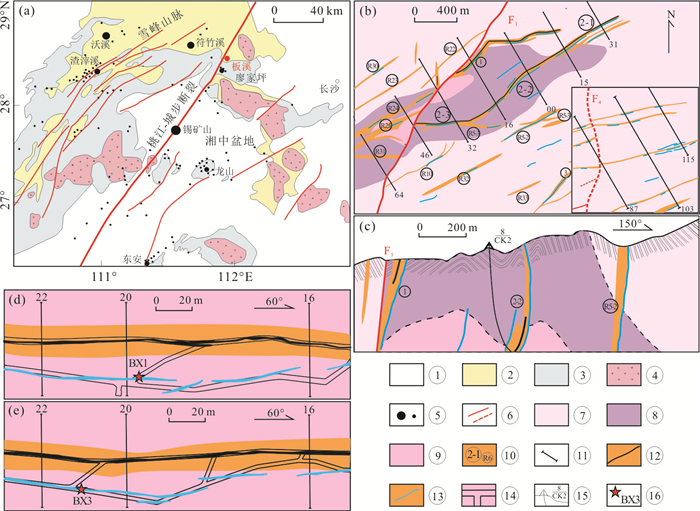
 下载:
下载:
